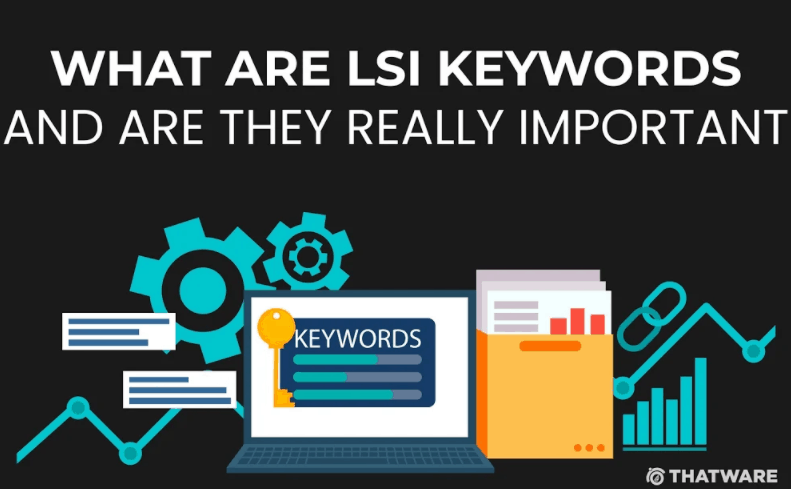SUPERCHARGE YOUR Online VISIBILITY! CONTACT US AND LET’S ACHIEVE EXCELLENCE TOGETHER!
Recently there has been a major debate in the SEO group on how we can always view keywords as SEO’s the North Pole, or instead concentrate on topics instead. Latent semantic indexing, or LSI, is the focus of this debate. LSI (Latent Semantic Indexing) keywords are related terms of a specific used term that search engines use to deeply understand the content on a webpage. LSI Keywords are not synonyms. Instead, they’re terms that are closely tied to your target keyword. LSI keywords have a high degree of correlation to a particular targeted topic.

👉THE PROCESS TO FIND OUT LSI KEYWORDS:
• Free LSI Tools
• LSI Graph
• Semantic Link
• LSI Keywords
• Ultimate Keyword Hunter
• Keyword Tool
• KWFinder
LSI keywords will close the marketer distance between how we build content now and whether we may need to do it in the future. They give us a way to speak about the changes to our SEO strategies that we need to make.
👉But first let’s understand what LSI keywords are?
Latent Semantic Indexing (LSI) is a machine search engine that analyzes the other terms that people use around a specific topic.
LSI keywords are terms and phrases that have a strong degree of relevance to the subject you like. The Google algorithm uses these to help assess the accuracy and importance of the information to the search word.
I’ve seen a lot of articles pointing to LSI keywords as intended keyword synonyms, but this is deceptive. This is more appropriate to claim that these are the terms most often associated with the high-value material quest. This requires synonyms but still a number more.
At this stage in search engine optimization, LSI keywords seem more relevant than keyword width, but let’s dive a little deeper.
👉BASIC PLACES TO FIND LSI KEYWORDS
• Google’s instant search:

• “Searches related to” results:

• Bold words in SERP results:

One of the most popular tools, Google AdWords Keyword Planner to find out LSI keywords.
👉HOW TO USE LSI KEYWORDS FOR YOUR SITE’S ADVANTAGE:
The main areas where you can place LSI keywords to get the most out of them:
• URL address
• Page title
• META tags
• Links anchor texts
• Last paragraph of text
• Images alt text
• H1 and H2 tags
• The first paragraph of text
• Body of content
👉Now let’s see what LSI keywords does?
Search engines use LSI to determine the accuracy of a page’s content by searching for terms that appear alongside a specified search phrase or keyword. Unlike every other SEO product we see these days, LSI has been developed to support searchers locate what they’re searching for and not only what they’ve been waiting for.
Google has reported that using more LSI keywords usually contributes to a better rank on your list. This makes sense as people are looking for every particular subject in various forms and a website with more LSI keywords not only provides more meaning and knowledge to Google, but also suit more users ‘ search terms.
👉How does LSI work?
The machines are dumb. They don’t have the innate knowledge of the connections we humans do for language.
Yet without being instructed a machine does not have the information.
The trouble is, there’s no way to explain anything to a machine. Everything really would require so much energy and commitment.
By utilizing complicated mathematical formulas to extract the relationship between terms and phrases from a series of records, LSI solves this question.
👉Finding and Using LSI Keywords
The pickings are slim when it comes to tools which can generate a collection of LSI keywords with semantic connections to your search name.
LSIGraph LSI Keyword Generator is the fastest, simplest and by far the least sketchy-looking resource we’ve found. You may start there.
You may also look at the “Searches related to” segment at the bottom of the first page of search results, since similar queries contain searches performed by people to answer with secondary inquiries, to explain a search word that they incorrectly phrased, etc. If you choose to search a little further, you can even look at the other words included in the sites that list the goal keyword for now.
Eventually, you will use subject modeling to create terminology linked to semantics that will render the material look more important to search engines.
Naturally, there are several different ways people search for the same subject. A small amount of your organic traffic (probably a minority) comes from your main keyword, and a large portion of your traffic comes from LSI keywords, long-tail keyword combinations, and other search phrases.
If you were to visualize the density of keywords in a piece of content, you might picture a page highlighted throughout with your target keyword. Looking at it this way, the intensity of the keywords seems small. And it has to be; otherwise, you risk being penalized for stuffing keywords.
However, you might visualize the keywords in your content as a network utilizing this keyword model. Begin with your goal keywords and picture lines running to LSI keywords. Such words often refer to each other, and you may create comparisons between them, too. A semantically connected network of terminology is the real abundance of keywords.
👉Now, where do people need to use LSI keywords?
- Throughout the page you wish to rate for the subject
- In headings and in the alt text, file names and titles of images
- Where appropriate, as the link anchor text
- In the Title tab to endorse the goal keyword, if necessary
- Using near related LSI keywords (but naturally) on the page
You may also generate additional content aimed at the LSI and long-tail keyword variations for the topics that are most relevant to your market, and then connect to it using the variation as anchor text.
You know those moments when you want to use your goal keyword or need to use it again; however, it begins to sound repetitive or spam? That is a great time to use a keyword for the LSI.
Thus, rather than goal keywords, start concentrating on topics and clusters of keywords that are semantically relevant to your content. When operating on the normal on-page SEO components, pick words from this collection, rather than inserting them in the goal keyword. Using the target keyword where all sounds normal and the maximum SEO value is generated, as in the title.
When it turns out, it’s not that complicated to manipulate LSI keywords. You actually still do a lot of this— after all, Google has been thinking about semantic scanning for a while, so it’s easy to substitute a similar word when items seem spammy is natural.
Leveraging Contextual Relevance: How LSI Keywords Enhance Content Value
In the world of SEO, search engines have evolved significantly from relying solely on keywords to understanding the broader context of content. One of the key factors contributing to this shift is the integration of Latent Semantic Indexing (LSI) keywords. These keywords, which are contextually relevant to a specific topic or main keyword, play a crucial role in enhancing the value of your content by making it more aligned with user intent and more easily understood by search engines.
Understanding Contextual Relevance
Contextual relevance refers to the relationship between terms or phrases within content, which helps search engines discern the subject matter’s depth and quality. Unlike traditional keyword optimization, where a focus is placed on repeating a target keyword, contextual relevance encourages the use of related terms and concepts that naturally tie into the main topic. This helps create a more comprehensive, user-friendly experience.
When you use LSI keywords, you’re essentially showing search engines that your content is relevant to a broader set of related queries. This not only improves the quality of the content for readers but also boosts the likelihood of ranking for a range of related searches, rather than focusing on a narrow set of keywords.
The Role of LSI Keywords in Enhancing Content Value
1. Broadening Topic Coverage
Using LSI keywords enriches the content by broadening its scope. For instance, if your target keyword is “vegan recipes,” LSI keywords could include “plant-based dishes,” “meat alternatives,” “vegan meal prep,” or “dairy-free options.” These terms, while not synonyms for “vegan recipes,” are highly related and help search engines understand that your content covers the entire spectrum of the vegan cooking niche. This increases your content’s relevancy and boosts its potential to satisfy a wider variety of user queries.
2. Aligning with User Intent
The core of any search engine’s algorithm is to match user intent with the most relevant content. By using LSI keywords, you’re addressing various aspects of what users might be looking for, even if their query is not an exact match to your target keyword. For example, someone searching for “easy vegan recipes” might also be interested in “quick vegan meals” or “vegan snacks.” Including LSI keywords helps you capture these nuances, making your content more likely to match the diverse needs of your audience.
3. Enhancing Content Depth and Authority
When you incorporate LSI keywords naturally into your content, you show that you’ve thoroughly explored the topic. Search engines favor content that not only answers the specific query but also provides a comprehensive understanding of the subject. By using a diverse range of related terms, you create a piece of content that provides more value and depth to your readers. This contributes to your content’s authority, signaling to search engines that your page is a trusted resource on the topic.
4. Reducing Keyword Stuffing
Keyword stuffing—repeatedly using the same target keyword in an unnatural or forced manner—is one of the fastest ways to damage your SEO ranking. By utilizing LSI keywords, you can avoid overusing the main keyword while still keeping the content relevant. This allows you to create a more natural flow of text that reads well for users while maintaining SEO value. For example, instead of repeating “vegan recipes” five times in one paragraph, you can use LSI keywords like “plant-based meals” or “vegan dishes,” keeping the content readable and still aligned with your SEO strategy.
How LSI Keywords Support Search Engine Algorithms
Search engines, particularly Google, use sophisticated algorithms to understand the context of a page’s content. LSI keywords play a crucial role in this process, helping search engines analyze relationships between different terms. For example, Google’s semantic search relies on the context of words and their connections to each other rather than focusing solely on exact keyword matches.
By incorporating LSI keywords, you help Google (and other search engines) build a better understanding of the broader topic and its various dimensions. This improves your content’s chances of ranking higher because it signals to search engines that your page is not just about a single keyword, but about a comprehensive, well-rounded discussion of the topic.
Finding and Implementing LSI Keywords
The process of finding LSI keywords has become easier thanks to various tools and techniques. Here are some ways to discover contextual keywords that enhance your content:
- Google Search Suggestions: Simply type your main keyword into Google, and look at the related search suggestions that appear at the bottom of the search results. These suggestions are often closely related to your main keyword and can serve as excellent LSI keywords.
- LSI Keyword Tools: Tools like LSI Graph and Keyword Tool are specifically designed to generate related keywords based on your main keyword. These tools help you quickly identify semantically relevant terms to include in your content.
- Search Engine Results Pages (SERPs): Another useful method is examining the SERPs for your target keyword. Look at the “Related Searches” section or scan through the bolded terms in the search snippets, as these are often indicative of LSI keywords.
- Competitor Content: By analyzing top-ranking content for your target keyword, you can identify patterns in the related terms used. This can provide insight into the LSI keywords that are being successfully integrated by competitors.
Best Practices for Using LSI Keywords
To effectively leverage LSI keywords and maximize their impact on your SEO strategy, it’s essential to use them in a way that feels natural. Here are some best practices:
- Integrate LSI Keywords Naturally: Avoid forcing LSI keywords into your content. They should fit naturally within the context of the text and add value to the reader’s experience.
- Use LSI Keywords in Key SEO Areas: Make sure to use LSI keywords in important SEO spots, such as headers (H1, H2), image alt text, meta descriptions, and anchor text. This signals to search engines that the page covers a broader set of related terms.
- Focus on Content Quality: While LSI keywords are important, the quality of your content should always be the priority. Don’t sacrifice user experience for SEO. Content that is valuable, informative, and engaging is the foundation for SEO success.
Incorporating LSI keywords into your SEO strategy is a powerful way to enhance content value and increase your page’s relevance to a wider range of searches. By focusing on contextual relevance rather than simply keyword density, you create content that is not only more discoverable by search engines but also more valuable to users. As search engines continue to evolve, leveraging LSI keywords will become an even more integral part of building high-quality, effective content.
The Evolution of SEO: Moving from Keywords to Topics and Semantic Clusters
Search Engine Optimization (SEO) has undergone a remarkable transformation over the years. Once dominated by keyword-centric strategies, SEO has now evolved to prioritize topics and semantic clusters. This shift reflects how search engines have grown more sophisticated, moving beyond basic keyword matching to understanding the broader context of content. By adopting a topic-first approach and leveraging semantic clusters, marketers can create content that is not only search engine-friendly but also highly relevant and valuable to users.
From Keywords to Topics: A Paradigm Shift
Historically, SEO strategies were heavily focused on keyword density and optimization. The primary goal was to match exact search terms to improve rankings. While this approach worked in the early days, it often led to content that felt unnatural, repetitive, and disconnected from the needs of users.
The rise of advanced search algorithms, like Google’s Hummingbird and RankBrain, has shifted the focus from individual keywords to understanding the intent behind searches. Modern search engines now aim to deliver results that best match a user’s intent, rather than simply matching exact keywords. This has given rise to the concept of topics, where content creators focus on covering a subject comprehensively, addressing a variety of related queries.
Semantic Clusters: The Building Blocks of Topical Authority
At the core of this evolution lies the concept of semantic clusters. A semantic cluster is a group of interrelated pieces of content centered around a core topic. For example, if the main topic is “sustainable living,” the cluster could include subtopics like “eco-friendly home design,” “minimalist lifestyle tips,” “renewable energy options,” and “green transportation methods.” Each subtopic is explored in depth, creating a web of content that collectively enhances the main topic’s authority.
Benefits of Semantic Clusters:
- Improved User Experience
Semantic clusters provide comprehensive answers to user queries. When readers land on your content, they can find all the information they need in one place, minimizing the need to navigate elsewhere. - Enhanced SEO Rankings
By interlinking related content, you signal to search engines that your site is a trusted resource on the topic. This improves your site’s topical authority and boosts its overall rankings. - Broader Keyword Reach
Content within a semantic cluster naturally incorporates a wide range of related keywords and phrases. This increases the likelihood of ranking for long-tail and semantic search queries.
How Semantic Search Fuels This Evolution
Modern search engines rely on semantic search to understand the relationships between words and their meanings within a given context. Instead of isolating keywords, search engines analyze how terms relate to each other and to the topic as a whole.
For example, a search query like “best laptops for students” involves understanding multiple dimensions:
- The intent: Finding laptops suitable for academic use.
- Context: Features like affordability, portability, and long battery life.
- Related terms: “budget laptops,” “student-friendly devices,” “best laptops under $500.”
By creating content that addresses these dimensions, you align with the way search engines process information and improve your chances of ranking higher.
Implementing Topic and Semantic Cluster Strategies
To leverage this evolution in SEO, marketers need to shift their approach from focusing on isolated keywords to building comprehensive content ecosystems. Here’s how to do it effectively:
1. Start with a Pillar Page
A pillar page serves as the central hub for your topic. It provides a broad overview while linking to in-depth subtopics. For example, a pillar page on “Digital Marketing” might include links to related subtopics like “SEO Best Practices,” “Social Media Marketing Tips,” and “Content Marketing Strategies.”
2. Create Cluster Content
Cluster content dives deeper into specific subtopics related to the pillar page. These articles are interlinked with the pillar page, creating a robust network of information that enhances both user experience and SEO.
3. Use Strategic Internal Linking
Internal linking is key to the success of semantic clusters. Each piece of content within a cluster should link back to the pillar page and to other relevant subtopics. This structure helps search engines understand the hierarchy and relationships within your content.
4. Incorporate Related Terms and Phrases
While exact-match keywords are still useful, incorporating related terms and phrases adds depth to your content. Use tools like Google’s Related Searches, Answer the Public, or keyword research platforms to identify relevant terms.
5. Focus on User Intent
Every piece of content within a semantic cluster should address specific user intents. For example, while the pillar page might answer broad questions, cluster content can focus on detailed how-tos, product comparisons, or case studies.
Benefits of Adopting the Topic-First Approach
1. Aligns with Search Engine Algorithms
Search engines are increasingly rewarding sites that demonstrate topical expertise. By focusing on topics and clusters, you align your content with what algorithms prioritize, boosting your visibility.
2. Builds Brand Authority
Comprehensive coverage of a topic positions your brand as a go-to resource, enhancing credibility and trust among users.
3. Supports Long-Term SEO Goals
While keyword-focused strategies often produce short-term gains, topic-based approaches provide sustainable results. Semantic clusters ensure that your content remains relevant as user behavior and search algorithms evolve.
Challenges in the Transition
Adopting a topic-first approach requires a shift in mindset and strategy. Some challenges include:
- Increased Time and Effort: Building a comprehensive content ecosystem demands significant planning and resources.
- Consistent Updates: As user needs evolve, your cluster content must be regularly updated to stay relevant.
- Balancing Depth and Simplicity: While in-depth content is important, it must remain engaging and easy to understand.
Overcoming these challenges involves investing in robust content planning, leveraging SEO tools, and maintaining a focus on quality.
End Note
Incorporating LSI keywords into your SEO strategy is essential for creating content that resonates with both search engines and users. By focusing on contextually relevant terms, you enhance content depth, improve user engagement, and align with search algorithms’ evolving standards. Prioritizing topics and semantic clusters over mere keyword repetition ensures a comprehensive and natural flow, ultimately boosting your site’s visibility and authority.

Thatware | Founder & CEO
Tuhin is recognized across the globe for his vision to revolutionize digital transformation industry with the help of cutting-edge technology. He won bronze for India at the Stevie Awards USA as well as winning the India Business Awards, India Technology Award, Top 100 influential tech leaders from Analytics Insights, Clutch Global Front runner in digital marketing, founder of the fastest growing company in Asia by The CEO Magazine and is a TEDx speaker and BrightonSEO speaker..


